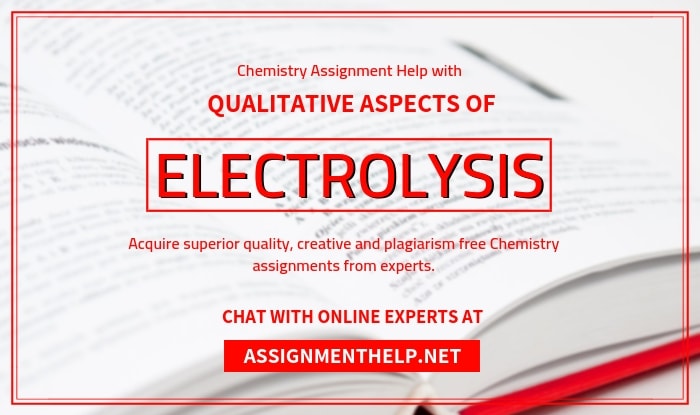Qualitative Aspects of Electrolysis Assignment Help
9.9 Qualitative Aspects of Electrolysis
The ability of an ion to get oxidized or reduced depends upon the size, mass, positive charge, negative charge etc. Thus, it is not possible to predict qualitatively that which ion would be discharged first, as one factor might enhance the ability to discharge while the other factor may hamper it. For a cation, the Standard Reduction Potential (SRP) values are compared. The cation having higher standard reduction potential value is discharged in preference to cation with lower SRP value provided the ions are at 1 M concentration. For an anion, the standard oxidation potential (SOP) values are compared and anion having higher SOP is preferentially discharged, if the concentration is 1 M for each of the ion. When solution of an electrolyte contains more than one type of cations and anions at concentrations different from 1 M, the discharge of an ion does not depend solely on standard potentials but also depends on the concentration of ion in the solution. This value is referred as potential, called as reduction potential for cation and oxidation potential for anion. The relation between reduction potential and standard reduction potential is given by Nernst equation, as

![]()
where ERP = Reduction potential of cation and ![]() Standard reduction potential of cation.
Standard reduction potential of cation.
Thus, it is possible that a cation (A+) with lower standard reduction potential getting discharged in preference to cation (B+) having higher standard reduction potential because their concentrations might be such that the reduction potential of A+ is higher than that of B+.
Qualitative Aspects of Electrolysis Assignment Help By Online Tutoring and Guided Sessions at AssignmentHelp.Net

Electrolysis is a chemical process that involves the use of electrical energy to drive a non-spontaneous chemical reaction. It is commonly used for various industrial processes, such as metal plating, water purification, and hydrogen production. Here are some qualitative aspects of electrolysis:
-
Electrolyte Selection:
- The choice of electrolyte is crucial in electrolysis. It must be a substance that can conduct electricity when dissolved in a solvent (usually water). Common electrolytes include salts, acids, and bases.
-
Electrolysis Cell:
- An electrolysis cell typically consists of two electrodes (anode and cathode) immersed in the electrolyte solution. These electrodes can be made of various materials, depending on the specific application.
-
Electrical Potential:
- To initiate the electrolysis process, an external electrical potential (voltage) is applied across the two electrodes. The anode is connected to the positive terminal of the power source, and the cathode is connected to the negative terminal.
-
Redox Reactions:
- Electrolysis involves redox (reduction-oxidation) reactions. At the anode, oxidation occurs as electrons are lost, and at the cathode, reduction occurs as electrons are gained. The specific reactions depend on the substances involved.
-
Generation of Ions:
- As the electrolysis process proceeds, ions are generated in the electrolyte. For example, in the electrolysis of water (H2O), hydrogen ions (H+) are produced at the cathode, and hydroxide ions (OH-) are produced at the anode.
-
Faraday's Laws:
- Faraday's laws of electrolysis describe the quantitative aspects of electrolysis, but they also have qualitative implications. These laws state that the amount of substance deposited or consumed during electrolysis is directly proportional to the amount of charge passed through the cell.
-
Gas Evolution:
- In some electrolysis processes, gases are evolved at the electrodes. For example, in the electrolysis of water, hydrogen gas is produced at the cathode, and oxygen gas is produced at the anode. The gases can be collected for various purposes.
-
Heat Generation:
- Electrolysis can generate heat due to the resistance of the electrolyte and the movement of ions. This heat can be a consideration in industrial processes to prevent overheating and maintain the efficiency of the system.
-
Electrode Reactions:
- The materials used for the electrodes can affect the overall efficiency and selectivity of the electrolysis process. For example, inert electrodes like platinum are often used to avoid unwanted side reactions.
-
Overpotential:
- Overpotential is the extra voltage required to drive a particular reaction at a desired rate. Understanding and managing overpotential is important for optimizing the efficiency of electrolysis processes.
In summary, electrolysis is a versatile chemical process with numerous qualitative aspects, ranging from the selection of the electrolyte and electrodes to the understanding of redox reactions, Faraday's laws, and the generation of gases and heat. These qualitative considerations are important for designing and controlling electrolysis processes in various applications.
Email Based Assignment Help in Qualitative Aspects of Electrolysis
We are the leading online Assignment Help provider. Find answers to all of your doubts regarding the Qualitative Aspects of Electrolysis in chemistry. We at assignmenthelp.net provide homework, Assignment Help to the school, college or university level students. Our expert online tutors are available to help you in Qualitative Aspects of Electrolysis. Our service is focused on: time delivery, superior quality, creativity and originality.
To submit chemistry Qualitative Aspects of Electrolysis assignment click here.


